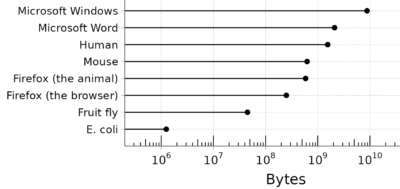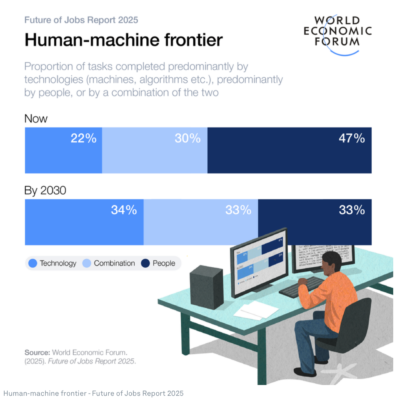New research debunks 4 myths about ‘impostor syndrome’
MIT Sloan School of Management
22 de enero de 2025
Myth 1: The impostor phenomenon is permanent.
Myth 2: The impostor phenomenon is more prevalent among women.
Myth 3: The impostor phenomenon is uniformly harmful.
Myth 4: Impostor syndrome creates negative outcomes through harmful patterns of behavior.
Future of Jobs Report 2025
World Economic Forum (wef)
7 de enero de 2025
Technological change, geoeconomic fragmentation, economic uncertainty, demographic shifts and the green transition –individually and in combination– are among the major drivers expected to shape and transform the global labour market by 2030.
– Broadening digital access is expected to be the most transformative trend with 60% of employers expecting it to transform their business by 2030.
– Increasing cost of living ranks as the second –most transformative trend overall– and the top trend related to economic conditions.
– Climate-change mitigation is the third-most transformative trend overall –and the top trend related to the green transition–.
– Two demographic shifts are increasingly seen to be transforming global economies and labour markets: aging and declining working age populations, predominantly in higher-income economies, and expanding working age populations, predominantly in lower-income economies.
– Geoeconomic fragmentation and geopolitical tensions are expected to drive business model transformation in one-third (34%) of surveyed organizations in the next five years. Over one-fifth (23%) of global employers identify increased restrictions on trade and investment, as well as subsidies and industrial policies (21%), as factors shaping their operations.
On average, workers can expect that two-fifths (39%) of their existing skill sets will be transformed or become outdated over the 2025-2030 period.
– Analytical thinking remains the most sought-after core skill among employers, with seven out of 10 companies considering it as essential in 2025. This is followed by resilience, flexibility and agility, along with leadership and social influence.
– AI and big data top the list of fastest-growing skills, followed closely by networks and cybersecurity as well as technology literacy.
While global job numbers are projected to grow by 2030, existing and emerging skills differences between growing and declining roles could exacerbate existing skills gaps. The most prominent skills differentiating growing from declining jobs are anticipated to comprise resilience, flexibility and agility; resource management and operations; quality control; programming and technological literacy.
Given these evolving skill demands, the scale of workforce upskilling and reskilling expected to be needed remains significant: if the world’s workforce was made up of 100 people,
59 would need training by 2030. Of these, employers foresee that
29 could be upskilled in their current roles and
19 could be upskilled and redeployed elsewhere within their organization. However,
11 would be unlikely to receive the reskilling or upkskilling needed, leaving their employment prospects increasingly at risk.
5 top takeaways from Davos 2025
Vía World Economic Forum (WEF)
24 de enero de 2025
There’s a momentum to the Annual Meeting that makes the five days feel like a journey. What’s news on Day 1 can feel like ancient history by Day 5. The cadence of this Davos was unique. Coming in the wake of a nascent ceasefire in the Middle East, and with the opening day coinciding with the US inauguration – the political and geopolitical calendars aligned. Conversations were provocative, and constructive, despite significant divergence.
- Geopolitics: in need of constructive optimism
- Climate, nature, energy: can it get back on track?
- Economic growth, finance: confidence is key
- Jobs, health, inclusion: rolling on – not rolling back
- AI, technology, industry: race against time and a race against each other
We’ve always been distracted
Vía Mind Tricks
24 de enero de 2025
Stadolnik afronta uno de los temas del momento, la capacidad que tiene la tecnología del entretenimiento para distraernos, y lo compara con lo que pensaba la gente cuando otras tecnologías revolucionarias (los libros, la televisión, etc) llegaron de manera masiva a las personas. ¿La conclusión? El ser humano siempre ha criticado todo lo que nos distrae, lo único que ha cambiado es el qué.
1. 2024 Annual Global M&A Report
…highlighting the industry’s robust rebound and setting the stage for continued growth in 2025.
In 2024, M&A activity increased by 14% in count and 19% in value YoY.
2. Build the bigger picture with our 2025 Outlooks
Join this webinar series to explore the private market trends to watch out for in 2025—along with the trends that defined 2024.
2 > Vía Pitch Book
1 de febrero de 2025
Cómo los Cambios Demográficos afectan los Mercados Financieros
Vía Samuel Izquierdo
1 de febrero 2025
Los cambios demográficos son una fuerza subyacente que moldea la economía global y, por ende, los mercados financieros. Comentaremos factores como el envejecimiento de la población, las tasas de natalidad, las migraciones y las transformaciones en la estructura familiar influyen directamente en el comportamiento de los inversores, la demanda de bienes y servicios, y las políticas económicas.
Mechanisms too simple for humans to design
…Malmesbury argues that humans are already great at building incredibly “complex” things—but nature still has us beat when it comes to designs of elegant simplicity.

A comparison of the size of software with the size of genomes. In that order: Windows > Word > Human > Mouse > Firefox (the animal) > Firefox (the browser) > Fruit fly > E. coli
You are simpler than microsoft word…
Innovation or Isolation: The Future of Regional Ecosystems – Startup Ecosystem Stars Report 2024
Vía Mind the Bridge (acceso a la descarga del informe)
4 de diciembre de 2024
Presentación del informe en youtube. The presentation shed light on:
• The World Scaleup Atlas: where scaleups are concentrated and how capital is distributed globally.
• The Innovation Ecosystem Life Cycle: the four stages of innovation ecosystems and the challenges of transitioning to the next level.
• Success Stories: how some regions are breaking through faster than the average.

